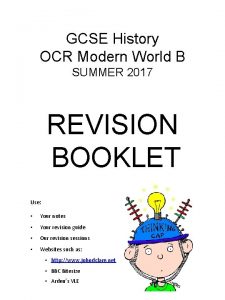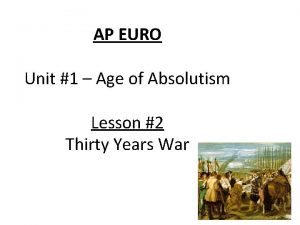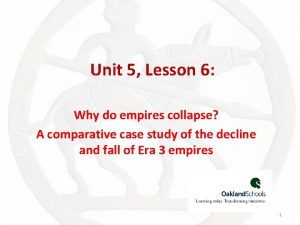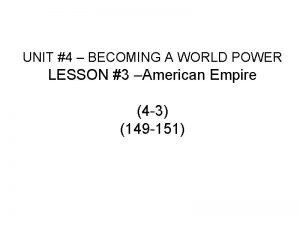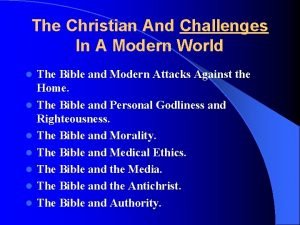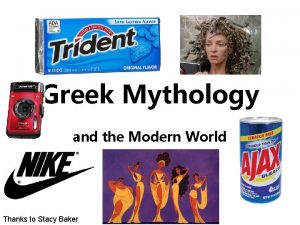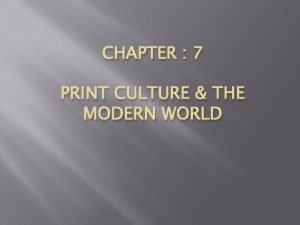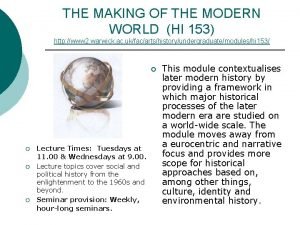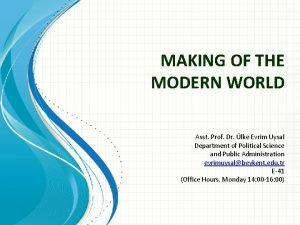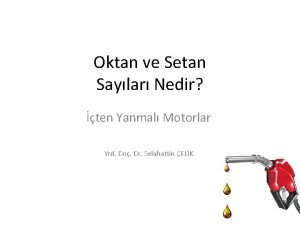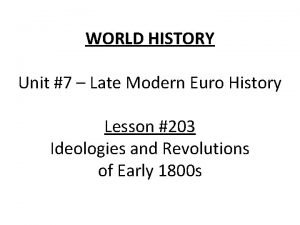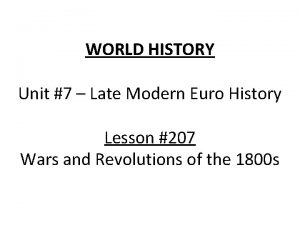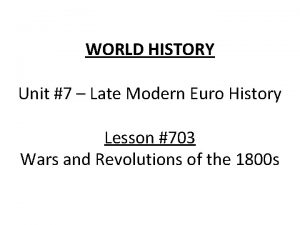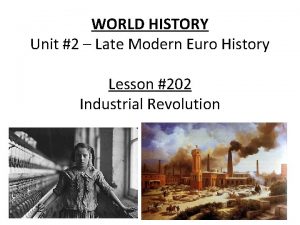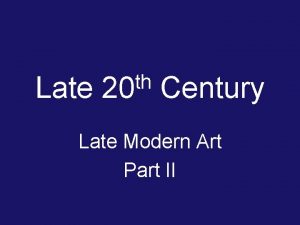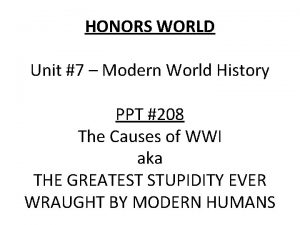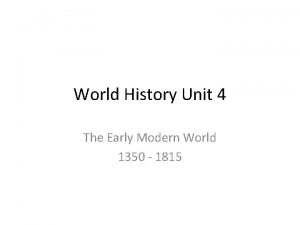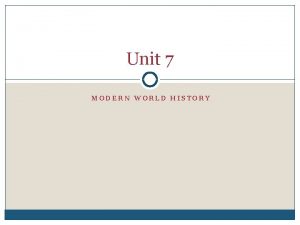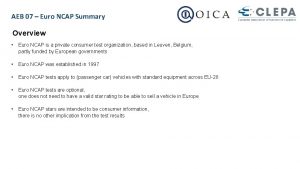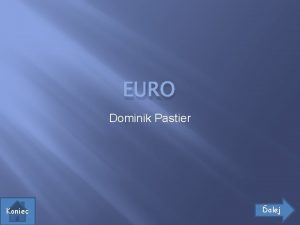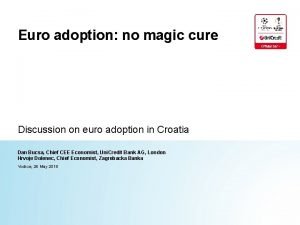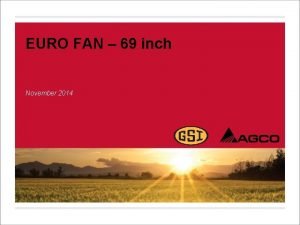WORLD HISTORY Unit 2 Late Modern Euro History
























- Slides: 24

WORLD HISTORY Unit #2 – Late Modern Euro History Lesson #201 Agricultural Revolution

New subject: the economy… AGRICULTURAL REVOLUTION

What WAS the Agricultural Revolution? 1. Textbook Definition of Agrig Rev. : The transformation of farming in Europe, from “subsistence” farming to farming for profit. 2. 80% of people in Western Europe still lived on the farm most were SUBSISTENCE FARMERS (% was even higher in the East) • • 3. What do you think that meant? “subsisted” on what they grew… never really accumulated wealth Each peasant family owned a few strips of land – what three things will they do with grain? • • 4. • • Trade some for other stuff (not usually enough for any of this) Eat some (turn to bread) Store some for winter Hold some back for “seed grain” for next season Output was poor: only five bushels harvest for every bushel sown Reason: they had no mechanism to plant efficiently – usually just tossed grain Every 3 seasons was poor; every 8 -9 was a disaster

The Start of the era • Population was back on the rise in the 18 th century • And was about to EXPLODE • More mouths to feed and same output meant: • (think: supply and demand…) • What would happen to bread prices? Why would this happen? • Bread prices up, farmers with land got richer • Rich land owners started looking for ways to maximize profits – GET RICH QUICKER • The Dutch and the English were the first to manage land more effectively for profit

The Open Field System • All life would change from this shift – why? How? • For more than 1000 years, Europeans survived with complete dependence on their village – People lived clustered in a village, surrounded by four sections of land, each divided into strips of land. Families owned a set # of strips, and as much as half was owned by the Lord • The whole village worked together, rotating the crop type each season – Each village had decided when to plant, what to plant – Wheat, rye, oats, beans • One section would be left to “fallow”

Open Field System

Open Field System

The Open Field System • Most people had some livestock, and let it wander on “common land” – Chickens, goats (for milk), sheep (for milk or wool) were common – Cows were usually killed by winter – too expensive to feed during the winter months – Most of the other animals were weighed against the grain they had to feel them through winter • Cattle (oxen) and horses were often owned in common, and were also pastured on common land (“the commons”)

Charles “Turnip” Townshend • Was a Whig MP – Chancellor of the exchequer for 10 years • Retired from politics 1730 – got in to experimental farming • Experimented with crop rotation: turnips and clover, instead of letting the land fallow • Huh? What am I talking about? • Clover replenished soil – what “need” will this eliminate? • Turnips were “fodder” crops – what will they now be able to do? – Now could keep animals alive through winter, especially cows


Combine that innovation with Bakewell’s scientific breeding. What is scientific breeding?

Robert Bakewell • Experimented with scientific breeding of cows – Why? To what end? • Goal: heartier, meatier cows producing more milk • He tried revolutionary techniques with grassland irrigation, flooding and fertilizing pasturelands • Result: – 1700: average bull weighed 370# at slaughter – 1786: weight was 840# • Sheep breeding was even more impressive – Who could benefit? – Who would likely NEVER experiment? • Was able to quickly select for large, yet fine boned sheep, with long lustrous wool

Enclosure Movement • Wealthy landowners were ready to invest in sheep raising – for what? • Increased population needed more clothing – How will sheep play into this? • Landowners bought out strips from peasants • They then “enclosed” land for “improvement” • What was being improved? • Who will benefit? • Who will not? • What will happen next?




Enclosure Movement • Parliament legislated the selling common land, forcing many peasants to sell their strips • Why would they do this? • What will happen to the stability of life for peasants? – disrupted farming communities – Favored nobility • How will this fuel the industrial Revolution? • Too early to fuel industrial revolution, but landless peasants will eventually move into cities and feed factories with cheap labor

Population Explosion • • Jethro Tull – SEED DRILL More effective farming for food, too Led to abundance of inexpensive food Fueled population EXPLOSION – Why? How? – Reason: decrease in infant mortality – (NOT because of any medical advances) • Additional reason: sanitation improvements – Clean water pumped into villages – Sewage pumped out, and away from water supply – Swamps drained (fewer insects) – Canals and roads built by absolutist rulers 1. 5 m

Seed Drill

Seed Drill – “then”

Seed Drill – “now”

Rotherham Plough • While not the first iron plough, it was the first iron plough to have any commercial success • technological innovations in its design • lighter than traditional ploughs; remained in use in Britain until the development of the tractor. • more efficient as it was light and economical enough in draught to be drawn by a pair of horses. Agrig Rev. Start at 1: 30 – 5 m

Introduction of American crops • Corn • Potato – Now the Irish get to be Irish • Squash • Tomato – Now, the Italians can get to the creation of pizza

Discussion questions for group: 1. 2. 3. 4. 5. 6. 7. What changed on the farms? Why did it change? What will be effected by the change? When will the common man benefit? Was the change a good thing for Europeans? Why did only the wealthy benefit, at this point? 8. What does it say about the goal of the government in England at this time?
 Ocr gcse modern world history revision guide
Ocr gcse modern world history revision guide Ap euro unit 6
Ap euro unit 6 Euro unit split
Euro unit split Ap world history chapter 25 africa and the atlantic world
Ap world history chapter 25 africa and the atlantic world Dangerous world tour history world tour - hockenheimring
Dangerous world tour history world tour - hockenheimring World history unit 5 lesson 6
World history unit 5 lesson 6 World history unit 4 lesson 3
World history unit 4 lesson 3 Unit 6 review questions
Unit 6 review questions Challenges of being a disciple in the modern world
Challenges of being a disciple in the modern world Print culture and the modern world
Print culture and the modern world What is language in mathematics in the modern world
What is language in mathematics in the modern world Greek mythology in the modern world
Greek mythology in the modern world Modern world youtube
Modern world youtube Print culture examples
Print culture examples Feminine eros
Feminine eros Making of the modern world warwick
Making of the modern world warwick Modern world
Modern world Ap euro thesis formula
Ap euro thesis formula Euro psy
Euro psy Amazone pri
Amazone pri Schlieffen plan ap euro
Schlieffen plan ap euro Romanticism ap euro
Romanticism ap euro 95 oktanla 98 oktan arasındaki fark
95 oktanla 98 oktan arasındaki fark Moedas euro países faces
Moedas euro países faces Münzen zur zeit jesu
Münzen zur zeit jesu
